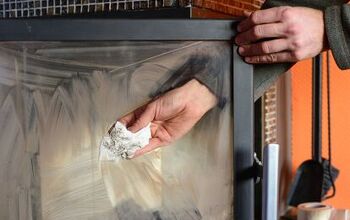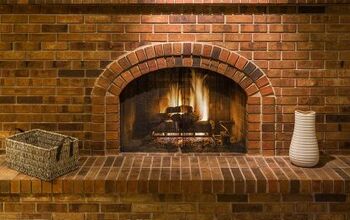How To Clean A Sandstone Fireplace

A sandstone fireplace is a wonderful feature to have in your home. They look fantastic, and provide some necessary cozy heat in the colder months. Because sandstone fireplaces have such strong visual appeal, it is important you keep yours looking its best throughout the year. This includes developing a cleaning schedule. But what is the best way to clean a sandstone fireplace?
The best way to clean a sandstone fireplace is to use a scrub brush with warm water and dish soap solution. Before you scrub, prepare the area by sweeping it and setting up drop cloths in the surrounding areas. For thicker layers of buildup, use a trisodium phosphate (TSP) and water solution to break down these layers. Take safety precautions and thoroughly rinse and dry the area afterward.
Cleaning your sandstone fireplace is not terribly complicated. It is, however, important you follow some basic but critical steps. This will help ensure that you safely and effectively clean your fireplace, and also leave it ready for further use.
How To Prepare Your Sandstone Fireplace For Cleaning
Before you do a deep clean of your sandstone fireplace, you need to make sure it is ready for such a task. It is important you do an inspection of your fireplace and then prepare it carefully for cleaning.
Pro Tip: Make sure you wait at least 12 hours after your last fire goes out before you prepare your fireplace for cleaning.
1. Inspect the Fireplace Surfaces
The first step in preparing your sandstone fireplace for cleaning is to give it a thorough inspection. Check for areas with particular buildup (anything 1/4 inch or thicker). This will help you determine if you require a simple soap and warm water mixture or a tougher solution with a scrub brush. This is also the time when you can determine what type of initial cleaning you need to do before you use a wet solution in your fireplace.
2. Sweep And Initially Clean Area Of Debris
After you inspect the area, you should sweep up and clean the area thoroughly to ensure any loose debris and ash has been removed from the area. Give the area a good sweeping to remove all the loose ash. You can even use a vacuum with a brush attachment to help suck up some of the more stubborn ash. The more of this debris you can remove before deep cleaning your fireplace, the less of a mess you will have to deal with.
3. Protect Hearth And Place Towels In Surrounding Area
The next important step in preparing your sandstone fireplace is to prepare and protect the surrounding areas. Cleaning a fireplace can be a messy task, but the last thing you want is for that mess to spread into the rest of your room. Place a tarp in front of the hearth. You should also have towels (that you aren’t worried about getting black and dirty) strategically. This will prevent stains and damage.
4. Create Safe Area For Cleaning Products
Just as you secured the area in front of the hearth, you should do the same for the area where you will keep the cleaning products. Place a tarp down, and ensure you have ample space for the cleaning bucket and brushes involved. This ensures no harmful chemicals or stained water will reach your floors or carpets.
5. Make Sure Safety Measures are in Place
The last step you need to take to ensure a successful fireplace cleaning is to ensure you have taken the necessary safety measures. This job requires safety gloves and ideally goggles as well. You will handle some harsh chemicals and hot water, so it is best to make sure your skin does not get harmed. Make sure you also have ample ventilation in the room so you are not inhaling any chemicals. This also promotes the drying process later on.
Use Dish Soap And Warm Water To Clean Sandstone
In many cases, once you finish your initial cleaning, you just need to scrub down your fireplace in order to remove most of the stubborn buildup that has formed. While chemical cleaners can be effective at removing dirtied ash, they can also damage and ruin your natural stone fireplace. This is why it is best to use warm water and a non-hazardous dish soap to clean your fireplace.
Step One: Prepare Wash Mixture
In a bucket combine hot (but not too hot to touch) water with a dish soap to the ratio of 1/4 cup dish soap to one quart of hot water. Once you have enough solution, stir it until well mixed.
Step Two: Scrub
Use a soft-bristles scrubbing brush (natural bristles like horsehair work great) to dunk into the solution. Scrub the entire sandstone fireplace area thoroughly, allowing the solution to soak into the stone and loosen up the surface where the grout is. Don’t forget to wear your gloves and goggles for this step.
Step Three: Scrub Again
Scrub the entire area thoroughly, carefully scrubbing in a circular motion in areas that are more affected by the grout and grit. Repeat this step until you have loosened up and removed the layer of dirt from the sandstone.
Step Four: Rinse
Replace the hot water and soap mixture with cold water (no soap this time). Use a rag to dip in the water and then begin to wipe away the dirt and soap layer left by the scrubbing. Continue this process until the area is wiped clean and no soapy residue remains.
Use TSP For Tough Stains And Buildup
If your fireplace has been neglected for sometime, or just has a particularly deep buildup of dirt and grime, you will need more than just dish soap and hot water to remove all the buildup on your stone fireplace. This is where trisodium phosphate comes in handy. Trisodium phosphate (TSP) is a highly effective chemical cleaner that will not corrode or damage sandstone if used properly.
To properly use TSP, follow the same methods as the dish soap method, but pay particular attention to safety. You should not use short sleeves or shorts. Make sure your body is covered, and perhaps even wear a face mask in addition to the ample ventilation.
To create a cleaning mixture, add one cup of trisodium phosphate to one gallon of warm water. Once you create this mixture, use a scrub brush to work it into the heavily soiled sandstone. Apply and scrub the entire soiled area. Spend extra time carefully scrubbing and reapplying the solution to areas with the most buildup.
Once you have removed the extra grime, you will follow the same steps of removal. Use cold water to get all the dirty solution removed. Once the solution and filth is removed, you can even use the dish soap solution to remove the last of the dirty surface. This will also help ensure there is no TSP remaining.
Dispose of TSP Carefully
TSP is highly alkaline, which means that while it is great to help clean your sandstone fireplace, it can damage other surfaces. Ceramic tiles, drains, faucets, pipes and aluminum are all susceptible to damage.
When you dispose of the solution, make sure you do so carefully, and if you do pour it down a faucet, be sure you are careful no splashing occurs, and you run water for a period of time after. This will prevent any damage caused by lingering TSP.
Final Thoughts On Cleaning Your Sandstone Fireplace
When you clean your sandstone fireplace, be sure you prepare the area well first. Once you have placed tarps or drop clothes, you should sweep and vacuum the fireplace. Try using hot water and dish soap to get rid of the dirty layer on top of your sand stone. When you have a regular cleaning schedule, this should work well.
If, however, you have a very dirty fireplace, you might need to use a TSP solution to break down the buildup. If you use TSP make sure you take safety precautions, dispose of it properly, and wipe the fireplace clean using clean water and clean rags.

Tom Gaffey is an expert writer who currently resides in Washington D.C. Tom has a passion for real estate and home improvement writing, as well as travel and lifestyle writing. He lived the last twelve years in Hawaii where he worked closely with luxury resorts and event planners, mastering his knowledge of aesthetics and luxury products. This is where he found his passion for home improvement and a keen interest in DIY projects. Currently, Tom resides in Washington D.C, and also working on his debut fiction novel.
More by Tom Gaffey



























